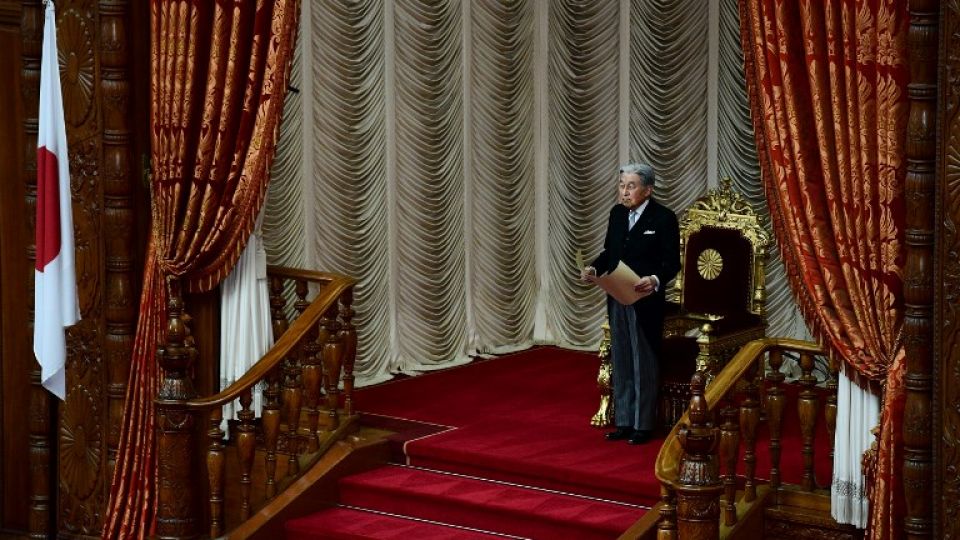April 1, 2019
Japan to unveil name of new era under Naruhito’s reign on Monday.
The end of an era is nigh for Japan, which will bid farewell to Heisei (achieving peace) when its revered Emperor Akihito steps down on April 30 and usher in a new epoch as the clock strikes midnight on May 1.
The country has been set abuzz guessing Japan’s 248th gengo, or era name, with shopping malls, retail outlets and even onsen hot spring resorts running campaigns asking customers for their predictions, while social media is also rife with forecasts.
One popular option online has been “Ankyu” (permanent peace), but observers believe that a name already in wide circulation will unlikely be chosen.
“I hope it will be an important era where everyone will be able to live with peace of mind,” Mrs Hitomi Kinoshita, 39, told the Asahi daily, after submitting her guess “Andai” at an onsen resort in Hirakata City in Osaka. Her husband Yasuhiro, 34, predicted “Taihei”. Both guesses comprise words that mean “peace”.
But it will be down to a select committee of nine panellists – comprising experts in Japanese literature, Japanese history, Chinese classics and Oriental history – to make the decision on Monday (April 1) morning. A Cabinet meeting will follow to approve an ordinance for the new name.
To prevent leaks from the top-secret discussions, everyone involved from the panellists to the Cabinet ministers will have to turn in their mobile phones and smart watches, and will be confined to the Prime Minister’s Office until the announcement.
Chief Cabinet Secretary Yoshihide Suga will, at 11.30am local time (10.30am in Singapore), announce the new era name by holding up a piece of paper with the two Chinese characters written in calligraphy – just as how then-chief cabinet secretary Keizo Obuchi had done in announcing “Heisei” in 1989.
Prime Minister Shinzo Abe will follow the nationally televised announcement with a news conference at 12pm, during which he will convey to the people the reasons behind the new name and his hopes for the new era.
That so much attention is being placed on the new era – to begin when Crown Prince Naruhito ascends the throne to become Japan’s 126th Emperor on May 1 – shows how this transcends a mere procedural change and can affect the overall mood of the Japanese.
While the Gregorian calendar is widely used in Japan, imperial dates are common on newspapers as well as official documents, where people routinely fill out the imperial year. Monday is April 1, Heisei 31 (shortened to H31 in many cases) in Japan.
Much like many in Western countries find meaning in periods like decades, which have given birth to such terms as “swinging 60s” and “90s’ kid”, people in Japan likewise colloquially identify with the eras (“Heisei children”).
More importantly, the era name is also meant to encapsulate a nation’s psychological hopes – though this backfired in the Showa (bright peace and harmony) period that spanned the rise of Japanese nationalism and led Japan to wage wars it then lost.
As per its name, the Heisei era, which Emperor Akihito has said he was heartened will come to an end without Japan having engaged in war, is associated with a period of peace.
But it will also be associated as an era of economic stagnation following the burst of the bubble economy, and of devastating catastrophes like the 1995 Kobe earthquake and the 2011 earthquake, tsunami and nuclear disaster.
There is no precedent for Monday’s announcement. Emperor Akihito will be the first Japanese royal to abdicate since 1817, after two centuries of the Chrysanthemum Throne changing hands only upon the monarch’s death.
This gives the government and businesses a rare “transition period” in the first era change in the digital age, as experts warn of a “Japanese Y2K” due to fears of a technological collapse over computers failing to register the new date.
A survey by the Ministry of Economy, Trade and Industry last week showed 20 per cent of companies were uncertain if their computer networks are using the Japanese calendar and are equipped to deal with the change.
To avoid confusion, experts say the new name – which must be easy to read and write and have two characters – will unlikely begin with the letters H, S, T, or M.
This corresponds to the first letter of the preceding four eras in modern Japan: Heisei (1989-2019), Showa (1926-1989), Taisho (“great justice”, 1912-1926) and Meiji (“enlightened rule”, 1868-1912).
The gengo system was first adopted by Emperor Kotoku in 645 and past emperors had sometimes switched era names midway during their reign to mark a fresh start following a period of tumult, whether due to wars or natural disasters.
While era names have only been changed with a change in emperor in modern Japan, the idea of a “reset” or a “fresh start” is still pervasive today.
Tohoku Gakuin University sociologist Kiyoshi Kanebishi told the Japan Times newspaper: “When I contemplate the meaning of the end of the Heisei era, I’m drawn towards the idea that it’s about putting to a rest a period of disasters and starting afresh.”


